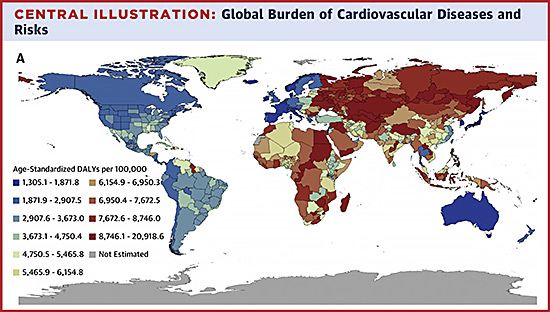Partnership plans to publish cardiovascular disease dashboard annually
January/ February 2023 | Volume 22 Number 1
Cardiovascular diseases consistently top the list of leading causes of death worldwide. These diseases—heart disease, stroke, brain bleeds, aortic valve calcification (hardening), heart failure due to alcoholism, aneurysm (a ballooning in the wall of a blood vessel) and endocarditis (inflammation of the heart lining), among others—also contribute to loss of health and excess health system costs.
How do public health researchers keep abreast of changing regional trends in prevalence and impact? The Global Burden of Cardiovascular Diseases Collaboration, an alliance between the Institute for Health Metrics and Evaluation, the National Heart, Lung, and Blood Institute, and the Journal of the American College of Cardiology (JACC), provides answers.
 Photo courtesy of Vaduganathan M, et al., Journal of the American College of CardiologyA map representing the global burden of cardiovascular diseases using Age-Standardized DALYs (disability adjusted life years). Red indicates the highest level of disease burden.
Photo courtesy of Vaduganathan M, et al., Journal of the American College of CardiologyA map representing the global burden of cardiovascular diseases using Age-Standardized DALYs (disability adjusted life years). Red indicates the highest level of disease burden.
Launched in 2020, this partnership has delivered a five-part region-specific series highlighting the distinct epidemiology of disease for East Asia, North America, South America, Sub- Saharan Africa, and Western Europe. Yet in December, the cardiovascular disease collaboration announced a small, though significant change. “Knowing that the global cardiovascular clinical and research communities desire these data with more frequency, it is our intent to publish results annually,” wrote Dr. Muthiah Vaduganathan and his co-authors in “The Global Burden of Cardiovascular Diseases and Risk: A Compass for Future Health.” Going forward, annual estimates can be used to guide allocation and prioritization of resources for research, health care, and public health, suggested the authors.
The December update is the first provided since the original launch in 2020. The Global Burden of Cardiovascular Diseases Collaboration is part of the larger
Global Burden of Disease (GBD) study, an ongoing multinational collaboration to provide estimates of population health over time. The original GBD was commissioned by the World Bank in 1990 to provide an assessment of disease burden from more than 100 diseases and 10 risk factors. The GBD, which is regularly updated with new data, presents more than one billion data points as a suite of easy-to-understand data visualizations.
More information
Updated February 14, 2023
To view Adobe PDF files,
download current, free accessible plug-ins from Adobe's website.
Related Global Health Research Topics